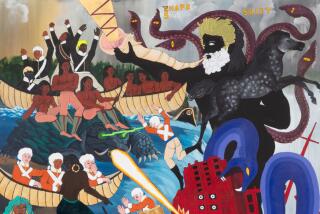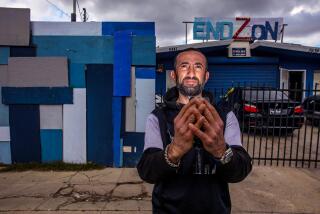Noted Western Artist Olaf Wieghorst Dies
- Share via
Olaf Wieghorst, one of this century’s most prominent Western artists whose work once hung in the Oval Office of the White House, died Wednesday after lapsing into a coma at Grossmont Hospital in La Mesa. He was 88.
A hospital spokeswoman declined to release the cause of death. But a longtime friend of the El Cajon resident told The Times that Wieghorst’s health began to deteriorate after a horseback-riding accident in October.
The friend--Scottsdale, Ariz., art gallery owner Troy Murray--said Wieghorst was riding with friends on a remote trail in Arizona when his horse bucked and rolled over on the feisty, outspoken artist. The artist suffered no broken bones but the accident left him weakened with bruises, blood clots and severe backaches, Murray said.
“From that time on, he was going downhill.”
The incident served as a sad irony for a man who prided himself on his equestrian prowess and credited his favorite animal with teaching him to paint.
“My greatest teacher has been the horse,” Wieghorst told The Times in a 1982 interview. “Observing and sketching horses in every kind of circumstance made me the painter I am. That’s how I learned anatomy and style and perfected my sketching.
“I couldn’t have learned what I did from some teacher in art school,” he said. “I learned about horses by sleeping, freezing, thirsting and starving with them. I learned by doing; I paint what I know.”
Horses, cowboys, mountain men, Navajo Indians--these were the things that Wieghorst knew. And he painted them so well that arts experts considered him this century’s answer to the famed Western artist, Frederic Remington, who produced most of his paintings and sketches in the 1880s and 1890s.
A typical Wieghorst oil painting would fetch about $250,000, while a watercolor would go for roughly $12,500, Murray said.
A Wieghorst painting entitled “Navajo Madonna” was purchased for $450,000 in 1982, then resold three years later with another piece called “Navajo Man” for $1 million, a price unheard of for Western art.
Three U.S. presidents collected Wieghorst paintings--Dwight Eisenhower, Gerald Ford and Ronald Reagan--as did a host of other prominent Americans, such as former U.S. Sen. Barry Goldwater, actors Clint Eastwood and Burt Reynolds, and tire magnate Leonard Firestone. Eisenhower had a Wieghorst painting hanging on a wall of the Oval Office during his eight years in the White House.
Possessing a photographic memory, Wieghorst never referred to photos in his work as other Western artists often do, Murray said. Instead, the artist would size up landscapes and scenes with his own eyes or from his memory before retreating to his El Cajon studio to reproduce them on canvas or in bronze.
His artistic trademark was attention to detail, and Wieghorst once said there was “nothing sweeter for me than an old cowhand to come up and tell me he recognized in my painting a certain kind of saddle or chaps he used to use.”
Wieghorst also credited television series such as “Gunsmoke” and “Rawhide” in the 1960s for opening the American public’s eyes to Western art.
“People began to see you don’t have to go to Italy or France to get a good painting,” he told The Times. “We have good painters and terrific subject matter right here in America.”
For Wieghorst, the subject matter was mostly autobiographical. More than most artists, he had lived his work.
Wieghorst was the son of a Danish photographer. He said he fell in love with the lore of the American West at the age of 10, when he read a Western pulp novel about Buffalo Bill.
With bucking broncos and cowpokes embedded in his young imagination, Wieghorst signed up nine years later as a seaman on a Danish merchant vessel traveling to the United States. He jumped ship in Hoboken, N.J., and joined the Army. As a member of the cavalry he helped chase Pancho Villa through the arid terrain of the Southwest.
Granted American citizenship because of his Army service, Wieghorst embarked on a varied career that included work as a cowboy for three years in New Mexico and then 20 years as a mounted policeman in New York City. In his spare time he sketched horses.
When Wieghorst was eligible to receive his 20-year pension, he left the New York force and went to El Cajon in 1944, where he took up painting full time.
His earlier work showed a “tightness,” said Bob Hill, director of the Art World Western Heritage Gallery in El Cajon. Murray said that, from the 1920s to the 1950s, Wieghorst used bold colors in his depiction of cowboys and horses.
During the 1950s, however, the artist seemed to mellow and he adopted the style that has become his trademark. His background and foregrounds, painted in softer colors, were impressionistic or often blurry.
Yet his central subjects were treated with riveting detail. Horses, said Hill, seemed to be alive with a “sense of movement” that could not be reproduced by other artists.
Murray said Wieghorst was prolific. He produced an estimated 3,000 paintings and sculptures. Wieghorst’s home studio was filled with Indian and cowboy artifacts, such as genuine war bonnets, and it overlooked the El Cajon Valley from a hilltop.
Murray also described the artist as a consummate story teller, often delighting visitors with humorous anecdotes about his own experiences as a cowboy and horse lover.
One favorite story, Murray said, was about the time that Wieghorst was a horse patrolman in New York. Checking an alley behind a Broadway theater, Wieghorst met Will Rogers, who had just finished a show. The budding artist told the humorist that he painted Western art.
The next night, Wieghorst returned with a painting of several horses hitched up in front of a saloon on a snowy winter night. Rogers took one look at the painting and said there was one thing missing: horse droppings.
Eager to oblige, Wieghorst took the painting home and added the missing detail. Returning yet again, he showed Rogers what he had done.
“ ‘That’s better,’ ” Murray quoted Rogers as saying. “ ‘But why aren’t those droppings steaming?’ ”
Unflaggingly optimistic and generous, Murray said the artist would freely give away sketches and prints worth thousands of dollars to strangers. One time, Murray said, he saw Wieghorst give a sketch worth about $3,000 to an airline attendant just in return for good food and beverage service.
That kind of generosity was repeated Wednesday. Just before Wieghorst slipped into a coma, he made sure that several Grossmont Hospital nurses received signed lithographs of his work. It was not an unusual gesture for Wieghorst, who has been a frequent patient, said Grossmont spokeswoman Sharon Ross.
“Each time he would be discharged, he would go through the halls handing out signed lithographs,” Ross said.
Murray described the horseback-riding accident the artist suffered in October. Even at 88, Wieghorst insisted on riding a horse on the Charro Trail near Tucson, which leads along the Mexican border where the artist once helped to chase Villa.
“Too many people were trying to help him,” said Murray. “He went to step up on the horse, and a man on the ground pulled on the horse’s head and Olaf pulled on the horse’s head.
“The horse got this tremendous yank on the bit and it just flipped him over.”
Wieghorst is survived by his wife, Mae; a son, Ray, and two grandchildren. The artist would have been 89 on Saturday.
Funeral arrangements, still incomplete, are being made by the Erickson-Anderson Funeral Home of La Mesa.
More to Read
The biggest entertainment stories
Get our big stories about Hollywood, film, television, music, arts, culture and more right in your inbox as soon as they publish.
You may occasionally receive promotional content from the Los Angeles Times.










